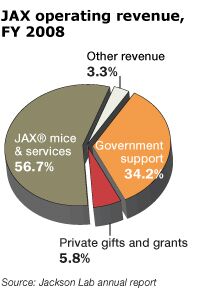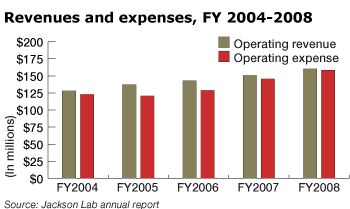Mice and Men
The price tag on a mouse bred at Jackson Laboratory in Bar Harbor runs anywhere from $11 to $300. The lower fee buys a basic, all-purpose mouse, fit for a variety of scientific experiments, while a bit more gets a custom rodent with a disease of the customer’s choice. The mice can be ordered online, in bulk, and packed up in temperature-controlled tractor trailers for delivery within days. While supplies last, take 25% off selected products. Just add shipping and handling.
All this may sound rather commercial for a nonprofit, world-renowned genetics research institution. But selling mice has been part of Jackson Lab’s mission ever since the 1929 stock market crash threatened its founding 80 years ago. Today, the lab houses and distributes more than 4,000 different strains of mice — ideal as a research model for their genetic similarity to humans — and is recognized worldwide for its diverse, reliable stock. It is not the only place to buy laboratory mice, but its rodents are indispensable to scientists across the globe researching how and why we get sick.
Revenue of $91 million from the lab’s mouse sales division, called JAX Mice and Services, constituted nearly 57% of its operating revenue in 2008. After a recession-related lag, its mice sales have rebounded, a major driver behind the lab’s decision to bring back to full time 315 workers whose hours were cut last spring. It is also looking to fill 55 jobs after announcing a hiring freeze one year ago, building additional research space just months after opening a new $4.7 million facility in August and mulling an expansion into Florida.
But as integral as mice are to Jackson Lab’s operations, the word “mouse” does not appear in its mission statement. The lab’s mice are the vehicle to a broader goal — discovering the genetic basis for preventing, treating and curing human disease and educating the world’s biomedical community. As lab President and CEO Richard Woychik put it, “We’re not a mouse place exclusively. We’re a health place.”
The lab wants to be a major player in the advancement of “personalized medicine,” a new era in which drug treatments are customized to the individual based on genetic findings. Imagine tests on a Q-Tip laden with DNA from a swab of your mouth telling your doctor whether one milligram or 10 milligrams of an anticoagulant is best for you. Or results showing that a mutation in your genes renders the cholesterol drug Lipitor ineffective for you, allowing you to circumvent both the cost and proven side effect of muscle weakness.
As Jackson Lab re-establishes firmer financial footing, it is also shifting its focus to the intersection of mouse and man. “We want to be in the position where we can draw on the power of both organisms’ genetics to better understand, how do diseases work?” Woychik says.
Prescription for change
Jackson Lab is eyeing a new facility in southwest Florida as part of its drive toward personalized medicine, enticed by incentives and the state’s attraction of top-notch research institutes through generous tax breaks. According to Woychik, adding a third location — the lab also has a facility in Sacramento, Calif. — would serve to “turbo charge” growth in Bar Harbor.
Sitting in his office at the 160-acre campus, with golden-hued rock faces jutting skyward just outside his window, Woychik outlines his vision for Jackson Lab’s role in one of the nation’s most pressing issues — health care reform. The gist of it is this: tailoring drug therapies to individuals, based on their genetic makeup, reduces ineffective and unsafe treatments and the cost of treating resulting side effects. “So you save the expense of the drug on individuals who are not going to respond to it,” he says.
Woychik, a mustached man with a fondness for analogies, likens disease to traffic, saying Jackson Lab will be a leader in teasing out the myriad mechanisms behind human illness, much like weeding out the car accidents, rush hours and various other factors that contribute to highway snarl ups.
He can recite a number of popular medications and their side effects from memory. Warfarin, for example, an anticoagulant, remains a problematic drug 50 years after entering the market. It can cause cerebral hemorrhage at the wrong dosage, a side effect that can run up $1.5 million in intensive care bills for a single patient, Woychik says.
While often expensive, the kind of genetic testing Woychik advocates is already in practice, such as with Erbitux, a colon cancer drug. “Right now the FDA requires a genetic test to determine whether or not you’re expressing a certain gene in your tumor,” he says. “Because if you’re not, don’t take the drug. You will have all of the side effects and you will have zero benefit.”
The research driving personalized medicine is happening both in-house at Jackson Lab and at the pharmaceutical companies and biotechs the lab supplies with its mice. The lab employs 218 researchers working to understand and better treat diseases including cancer, osteoporosis, AIDS, obesity and glaucoma. Last year, the lab distributed 2.5 million mice — which are genetically pure through inbreeding — to 16,000 investigators in 60 countries. Many of them couldn’t do similar testing otherwise, Woychik says. “There are major pharmaceutical companies whose R&D efforts are dependent on the resources that we create here. We’re doing experiments in mice that will make it safer to bring a drug into clinical trials.”
The lab also provides education and training for up to 3,000 scientists a year, and runs an up-to-the-minute public database cataloging mouse gene mutations and experimental data.
But Jackson Lab also wants to keep some things private. It has two patents pending — one for an effective way to freeze and thaw mouse sperm and one for a process that essentially prevents lab mice from evolving, thus ensuring the consistency of the research based on them. For a nonprofit, particularly one that serves academics who depend on sharing research results, balancing such commercial ventures with the overall mission is key. Even the lab’s founder, biologist Clarence Cook Little, faced criticism over making the original choice to sell mice strains to outside researchers, after philanthropic contributions dried up with the stock market crash.
For Woychik, licensing and patenting discoveries at the lab — which he describes as “a very aggressive pursuit for me” — furthers its research into human disease. “Our driver is not creating revenues,” he says. “It’s maximizing return on our mission.” He points out that some of the lab’s work is fundamentally unprofitable, such as maintaining 4,000 strains of mice despite fluctuating demand for many of them.
On the rebound
Charles Hewett descends from his office through a warren of hallways leading to Jackson Lab’s cryopreservation room. Inside, a man wearing a lab coat and pink gloves raises the lid on a 5-foot tall stainless steel tank. Through a fog of liquid nitrogen, he lifts out a long, narrow receptacle storing the frozen genetic material of many, many mice.
“We’ve figured out how to freeze and thaw sperm so the sperm is as effective, and for some lines of mice more effective, for fertilized eggs than fresh sperm,” says Hewett, the lab’s chief operating officer. Jackson Lab has been cryopreserving mice — as embryos, sperm and ovaries — for more than two decades, and can produce live mice from its frozen stocks typically within 15 weeks from when an order is placed. The lab’s own foundation stocks are refreshed every five generations from frozen material to prevent “genetic drift,” or random evolutionary variations.
Hewett, a small, trim man with a way of turning up his mouth in a perpetual almost-grin, goes on to describe two other lines of business for the lab. Its custom breeding service creates and supplies researchers with unique mouse strains. Standing orders, say 50 mice a month, assure regular delivery. All of the lab’s mice are raised according to rigorous health and hygiene standards in isolated cages designed to prevent the spread of infection. The grainy smell of the mice’s steam-cleaned feed permeates the air in the cryo room, mixing with chemical notes of antiseptic.
Jackson Lab also provides mice that can accept human tissue, allowing researchers to test the efficacy of new drugs on as human-like a subject as possible. Hospitals provide the lab with human tumors that can be inserted into the mice, furthering research into cancer drugs, as well treatments for illnesses including as obesity and diabetes. “You’re one step closer to really studying the human disease in life, not in a petri dish,” Hewett says.
The lab is currently embroiled in its first-ever patent dispute over its “humanized” mice. In an unusual case, a Japanese firm claims the lab infringed on its patent for the immunodeficient mouse strain. Jackson Lab disputes the claim, and was surprised to be hauled into court by a fellow nonprofit research institution without even a phone call first. Jackson Lab’s lawyer, David Einhorn, was quoted in the journal Nature in June, saying “the affair is completely uncivil.” The matter is now headed for court-mandated mediation, Hewett says.
But the lab continues to move forward, and recently announced it’s looking to add 55 workers to its ranks of 1,400 in Bar Harbor. Some new positions will support promising young research scientists in the lab, while others are open to high school graduates interested in caring for and feeding the mice. The rebound is due in large part to a 10% rise in mouse sales and research services over last year, Hewett says. That’s in light of competition from for-profit mouse distributors, including Charles River of Wilmington, Mass., Taconic Farms of Hudson, N.Y., and Indianapolis-based Harlan Laboratories.
According to Hewett, a $12 million to $15 million deficit the lab had projected for this year, before revenues rose and costs were cut, is now off the table. Still, the lab’s endowment portfolio has taken a hit, dropping from just over $80 million to about $60 million today. “We’ve recovered,” he says. “Not every business line is back.”
Another boon has come in the form of grants from the National Institutes of Health, the lab’s main outside funder and a source of financing for many of the institutions that buy its mice. NIH was awarded more than $10 billion through the stimulus act, much of it for genetics research, and Jackson Lab alone has received more than $13 million for research and building construction.
In June, the lab won $2.1 million through the Maine Technology Asset Fund to expand research space and purchase new equipment. According to lab officials, Jackson has delivered a $6 to $7 return on investment for every state dollar invested in the lab over the last five to 10 years.
Jackson Lab has its sights set beyond Maine, however, as it moves into a new era in treating human disease and suffering. The lowly lab mouse is a platform for something much, much larger. “We do research and we make discoveries and we share those discoveries with the world,” Woychik says.
Jackie Farwell, Mainebiz staff reporter, can be reached at jfarwell@mainebiz.biz











Comments